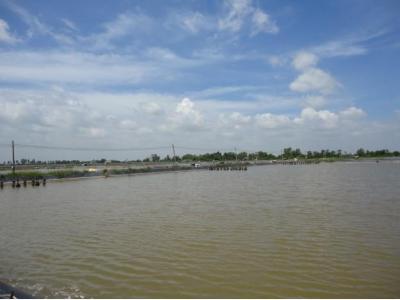Bacillus Probiotics Improve Hatchery, Nursery Production In EMS-Hit Mexico
n early 2014, a trial to evaluate the effects of a mixture of Bacillus strains on early mortality syndrome bacteria during the larviculture and nursery phases
 Biosecurity For Shrimp Farms
Biosecurity For Shrimp Farms With the global spread of viruses that affect farmed shrimp, biosecurity has become an essential element of every farm operation.
 Cefas develops technology to help combat shrimp disease
Cefas develops technology to help combat shrimp disease Cutting edge farmer-led disease diagnostics technology could help combat devastating disease outbreaks in global fish and shellfish production
 Challenges of RAS technology
Challenges of RAS technology Lack of suitably experienced RAS managers and operators. Former cage or hatchery managers are not necessarily sufficiently well qualified
 Effects of Sterol supplements on Shrimp Growth, Survival
Effects of Sterol supplements on Shrimp Growth, Survival A study found the quality and levels of sterols in experimental feeds affected the growth performance of Pacific white shrimp.
 Intensive Farm In Bali, Indonesia, Produces Shrimp In Biofloc System
Intensive Farm In Bali, Indonesia, Produces Shrimp In Biofloc System Bali Island in Indonesia is a popular tourist destination. However, a few aquaculture facilities, including small shrimp farms
 Laval shrimp nutrition
Laval shrimp nutrition Astable supply of high-quality postlarvae (PL) is an essential requirement to guarantee the future sustainability of shrimp production.
 Mixed Maturation Diets Improve Shrimp Broodstock Performance
Mixed Maturation Diets Improve Shrimp Broodstock Performance Interest in captive reproduction of penaeid shrimp is increasing worldwide due to the urgent need to establish selective breeding programs and produce certified
 New nursery diet for shrimp performs well at super-high stocking densities
New nursery diet for shrimp performs well at super-high stocking densities Interest has renewedin multiphase shrimp production, where shrimp postlarvae (PL) are stocked in intensive raceway tanks during a short nursery phase
 New technology proves effective for EMS-hit shrimp farmer
New technology proves effective for EMS-hit shrimp farmer This bacteria, which has both virulent and benign strains, causes acute hepatopancreatic necrosis disease (AHPND) or early mortality syndrome (EMS) in shrimp.
 Ongoing Studies Advance Intensive Shrimp Culture In Zero-Exchange Biofloc Raceways
Ongoing Studies Advance Intensive Shrimp Culture In Zero-Exchange Biofloc Raceways In ongoing trials of greenhouseenclosed intensive biofloc shrimp culture systems, the objectives of a 2012 study were to evaluate the performance
 The importance of dissolved oxygen in Pacific White Shrimp Culture
The importance of dissolved oxygen in Pacific White Shrimp Culture At present, industrial scale marine shrimp producers in almost every country produce the same kind of shrimp-- Pacific White Shrimp, or White Leg Shrimp
 Whitespot resistant gene could save shrimp industry millions
Whitespot resistant gene could save shrimp industry millions White spot syndrome is still one of the most serious diseases for shrimp farmers across Asia and South America, with no effective way of combating it.
 Feed management improves profits in intensive white shrimp farming
Feed management improves profits in intensive white shrimp farming To ensure optimal water quality and clean pond bottoms at shrimp farms, choosing consistently goodquality feed and close monitoring of feed trays supported
 Four-Phase, Biosecure System Produces Shrimp Broodstock in Ecuador
Four-Phase, Biosecure System Produces Shrimp Broodstock in Ecuador Virus (WSSV) in Ecuador has been the implementation of new management strategies in broodstock growout practices
 Effective Management Of WSSV In Shrimp - A Seven-Step Program
Effective Management Of WSSV In Shrimp - A Seven-Step Program As research on WSSV continues, common-sense steps can lessen the potential impacts of white spot syndrome virus on shrimpfarming operations
 Two-Stage Selection Key For Fast Shrimp Growth In Mexico
Two-Stage Selection Key For Fast Shrimp Growth In Mexico The largest shrimp hatchery in Mexico has implemented a two-stage selection program based on body weight at 28 days of age and and body weight at 130 days
 Recirculating Aquaculture Tank Production Systems An Overview of Critical Considerations
Recirculating Aquaculture Tank Production Systems An Overview of Critical Considerations In many areas of the United States, traditional aquaculture in ponds is not possible because of limited water supplies or an absence of suitable land for pond
 Brazil’s Intensive Shrimp Nursery Systems Improve P.L. Management, Shorten Growout
Brazil’s Intensive Shrimp Nursery Systems Improve P.L. Management, Shorten Growout Intensive nursery systems function as an extension of hatcheries and are an effective way to acclimate postlarvae to farm conditions and assess their quality
 Shrimp Broodstock Nutrition - A Review
Shrimp Broodstock Nutrition - A Review Research into shrimp broodstock nutrition will be a key element in the further use of domesticated and genetically selected stocks for aquaculture
